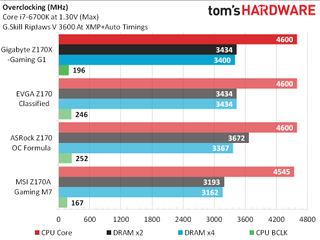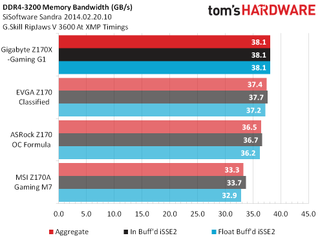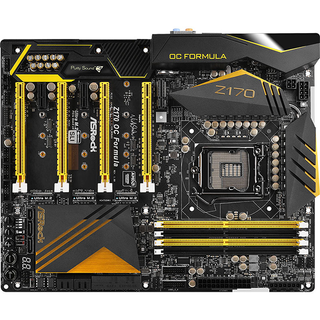Gigabyte Z170X-Gaming G1 Motherboard Review
Shooting straight for the top of the enthusiast LGA 1151 market, Gigabyte's Z170X-Gaming G1 is packed with features including four-way SLI, dual networking and Wi-Fi. Might this be the best Skylake motherboard we've tested?
Why you can trust Tom's Hardware
Test Results, Overclocking And Conclusion
To assure accurate comparisons, we repeat the benchmark configuration from our initial Z170 roundup in every Z170 motherboard review.
Synthetic Benchmarks
Gigabyte's Z170X-Gaming G1 gets sixteen lanes to its top slot through its PEX8747 Switch, while EVGA's Z170 Classified bypasses the switch in single-card mode but is limited to only eight lanes. Added latency from that switch puts the Z170X-Gaming G1 slightly behind in 3DMark, a test which isn't bandwidth-intensive enough to pull down the Z170 Classified.







Apart from that tiny deficit in 3DMark, the Z170X-Gaming G1 performs on-par with the top two boards in synthetic benchmarks.
3D Games




The Z170X-Gaming G1 finishes less than 1 percent behind the gaming performance leader, in spite of the small latency penalty of its PEX8747 switch. That switch is required to run three or four cards in SLI, so that sounds like a solid trade-off.
Timed Applications




The Z170X-Gaming G1 shows average performance in every timed benchmark, which is great since any significant deviation from average would have indicated a problem. We like problem-free products.
Power, Heat And Efficiency
It probably makes sense that the board with the greatest number of onboard controllers consumes the greatest amount of energy, yet power misers will still be shocked to see differences of up to 20W. If these results offend you, you're welcome to disable things you're not using. The Wi-Fi controller, perhaps?




Heat also reduced the efficiency of voltage regulators, and lower-efficiency voltage-regulators likewise produce more heat, so the 20W at load is starting to make sense. We could have aimed a fan directly at the voltage regulator, or connected its water line to a liquid cooler, but those changes would have skewed this comparison. We'll reluctantly settle for a 15.5 percent below-average efficiency rating.
Overclocking
Gigabyte produced a special F5i beta firmware to overcome mediocre memory overclocking, but we're not able to use it in overall evaluation simply because it hasn't been verified yet. At least that firmware was public when we started testing, and it even produced record-high four-DIMM data rates.
| Gigabyte Z170X-Gaming G1 BIOS Frequency and Voltage Settings | |
|---|---|
| BIOS | F4 (09/08/2015) |
| Base Clock | 80-500 MHz (10 kHz) |
| CPU Multiplier | 8x-127x (1x) |
| DRAM Data Rates | 800-4133 (100/133.3 MHz) |
| CPU Vcore | 0.50-1.80 V (5 mV) |
| System Agent | 0.80-1.30 V (5 mV) |
| CPU I/O | 0.80-1.30 V (5 mV) |
| PCH Voltage | 0.80-1.30 V (20 mV) |
| DRAM Voltage | 1.00-2.00 V (10 mV) |
| CAS Latency | 5-31 Cycles |
| tRCD | 1-63 Cycles |
| tRP | 1-63 Cycles |
| tRAS | 1-127 Cycles |
Switching back to validated F4 firmware, the Z170X-Gaming G1 is still no slouch in the clock comparison.

The Z170X-Gaming G1 also produced adequate bandwidth at nonstandard frequency, indicating that Gigabyte hasn't used performance-impairing timings to produce higher clocks. However, it wouldn't reach DDR4-2933 without enabling XMP timings.

Want more? We've been collecting additional memory data since the outset of Z170 motherboard testing, including DDR4-3200 bandwidth data on boards that would support it. All of the top models are DDR4-3200 capable, but Gigabyte's Z170X-Gaming G1 takes the prize in bandwidth.

Oh, and in case you were thinking of using that beta firmware to reach DDR4-3600 (four DIMMS) or DDR4-3672 (two DIMMS) but are now afraid that its data-rate-boosting settings might have resulted from performance-penalizing timings, we tested it at both DDR4-2933 and DDR4-3200. Bandwidth remained virtually unchanged.
Gigabyte did a great job of boosting the feature set of its Z170X-Gaming G1, but who would pay $473 for a mainstream-platform motherboard? Perhaps it would be better to question buyers of the competing EVGA Z170 Classified, since that board has far fewer features yet still costs $400. Gigabyte's biggest feature advantages are its Thunderbolt 3 and 802.11ac MIMO Wi-Fi controller, though a bunch of smaller things such as its front-panel USB 3.1 bay adapter, bundle of SLI bridges and integrated liquid-cooling provisions are probably worth as much as those two "big" features. In total, it appears the Z170X-Gaming G1 is worth at least twice its price difference over the Z170 Classified, and that makes it the board we'd choose for a cost-be-damned overclocked Core i7-6700K gaming rig.
MORE: Best MotherboardsMORE:
How To Choose A MotherboardMORE: All Motherboard Content
Thomas Soderstrom is a Senior Staff Editor at Tom's Hardware, covering Cases, Cooling, Memory and Motherboards. Follow him on Twitter.
Current page: Test Results, Overclocking And Conclusion
Prev Page Z170X-Gaming G1 Software And FirmwareStay on the Cutting Edge
Join the experts who read Tom's Hardware for the inside track on enthusiast PC tech news — and have for over 25 years. We'll send breaking news and in-depth reviews of CPUs, GPUs, AI, maker hardware and more straight to your inbox.
-
Crashman Reply
Lesson to manufacturers, give me more to write about and I'll write a bigger article?17171729 said:That was a great article, thanks.
-
red77star 6 Core i5820 is cheaper than quad core top of the line Skylake. The thing is that LGA 2011 V3 is going to support future CPU where this board is pretty much stack at Skylake.Reply -
Rookie_MIB Why is nobody actually testing the best features of the board? Quad SLI? Raid M.2? This is a top of the line board and not a single result of the biggest questions.Reply -
James Mason Reply17172008 said:6 Core i5820 is cheaper than quad core top of the line Skylake. The thing is that LGA 2011 V3 is going to support future CPU where this board is pretty much stack at Skylake.
Proof?
Also the top of the line skylake i7-6700k is currently being price gouged a bit. You can get it at microcenter for only 359. The i7-5820k is quite a lot more power hungry than the skylake. -
Math Geek this is the 3rd article i have read on this mobo from 3 different sites and yet no one has bothered to see what the 3 m.2 slots can do in raid set-up. that was the first thing that stood out to me when i saw the board and no one has even tested it yet.Reply
in my opinion if you are going to review a top of the line "cost-be-damned overclocked Core i7-6700K gaming rig", the fill that sucker up with what it can handle and let's see what it can do. try out some m.2 raid and at least 3 way sli. someone paying this kind of money for a mobo is gonna go all out and i'd love for the review to go all out as well :)
otherwise the rest of the info is nice and complete as usual. just need the last couple chapters and it would have been perfect -
rolli59 Very nice board that appeals to the <1% market since most people do not use the added expensive features.Reply -
Crashman Reply
None of us has three or more matching cards to put at one lab. But I'm thinking about doing another PCIe Scaling in SLI article like I did a few years ago with the P67.17172176 said:Why is nobody actually testing the best features of the board? Quad SLI? Raid M.2? This is a top of the line board and not a single result of the biggest questions.
What do you think? I might be able to get someone to pitch in some cards for that :)
The entire PCH has only the bandwidth of a single M.2 slot, and that's also shared with the Thunderbolt 3 controller. As the article state it's pointless to try to load up more than 32GB/s in devices at the same time.17173073 said:this is the 3rd article i have read on this mobo from 3 different sites and yet no one has bothered to see what the 3 m.2 slots can do in raid set-up. that was the first thing that stood out to me when i saw the board and no one has even tested it yet.
in my opinion if you are going to review a top of the line "cost-be-damned overclocked Core i7-6700K gaming rig", the fill that sucker up with what it can handle and let's see what it can do. try out some m.2 raid and at least 3 way sli. someone paying this kind of money for a mobo is gonna go all out and i'd love for the review to go all out as well :)
otherwise the rest of the info is nice and complete as usual. just need the last couple chapters and it would have been perfect



